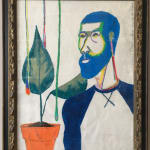

Derrick Alexis Coard
Rain for the Plants, 2012
Pastel on paper
63.5 x 45.7 cm
Signed, dated, and titled
Copyright The Artist
Exhibitions
http://galerie-zander.de/archive.php?lang=en&a=derrick_alexis_coard_07062018Literature
https://frieze.com/article/derrick-alexis-coards-tender-studies-black-masculinityCrip Time MMKFrankfurt -Derrick Alexis Coard, who died in August 2017 at the age of thirty-six, primarily painted and drew Black men with full beards. But these paintings were not self-portraits. The men are imaginary and represent Coard’s exploration of the self-image and self-understanding of African American masculinity. In the works shown here, the eyes of the men portrayed are open, except for the painting The Black Man That Lives On Park Ave. (2014), which depicts a man wearing sunglasses. Although this picture refers to a certain idea of class-consciousness—according to the title the man lives on Park Avenue, New York, a neighborhood long-associated with an expensive, upscale lifestyle—Coard’s works convey little of the new Black self-confidence projected by those who spearheaded the 1960s Civil Rights Movement, such as Malcolm X, Martin Luther King, or singer James Brown with his “I’m Black and I’m Proud.” Most of the men looking out from the portraits are more hesitant, skeptical, and broken. However, there are personal reasons for the sense of vulnerability and brokenness that one encounters in the images. Born in Brooklyn in 1981, Coard experienced bouts of severe depression even during his youth, which were repeatedly accompanied by extended hospitalizations. Early on, painting became a means of self-assurance for him in terms of how others saw him. This is conveyed by titles such as The 10th Jon Healed From Mental Sorrow (n.d.) or The Pastor’s Healing Ration (2015). The figure of the “pastor” brings an additional element to the fore: Coard’s deep spirituality as expressed in his paintings. Anointing Fall On Me (2015) shows a portrait of a man in profile, whose head is surrounded by a yellow halo. This motif, which appears frequently in icon painting, serves as a clear reference to the fact that he considered relief, even if brief, as more indebted to art and spirituality than the mundane realities of the clinic
1
of
3

